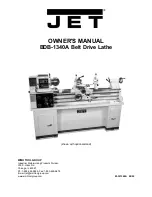
7
WARNING
Machine is heavy! Use an appropriate
lifting device and use extreme caution when
moving the machine to its final location.
Failure to comply may cause serious injury!
Uncrating and Clean-Up
1. Finish removing the wooden crate from
around the lathe.
2. Unbolt the lathe from the shipping crate
bottom.
3. Choose a location for the lathe that is dry,
has good lighting, and has enough room to
be able to service the lathe on all four sides.
4. Assemble parts fastened to the crate bottom
used to lift the lathe. See Fig. 1. (Note:
Lifting parts are not tightened in Fig. 1 to
show detail.) Using a piece of leather or a
block of wood under the metal block to
protect the ways during lifting is highly
recommended. Do not lift the lathe by the
spindle. With adequate lifting equipment,
slowly raise the lathe off the shipping crate
bottom. Make sure lathe is balanced before
moving to sturdy bench or optional stand.
5. To avoid twisting the bed, the lathe's
location must be absolutely flat and level.
Bolt the lathe to the stand (if used). If using
a bench, through bolt for best performance.
6. Clean all rust protected surfaces using a
mild commercial solvent, kerosene or diesel
fuel. Do not use paint thinner, gasoline, or
lacquer thinner. These will damage painted
surfaces. Cover all cleaned surfaces with a
light film of Mobil DTE
Oil Heavy Medium.
7. Remove the end gear cover. Clean all
components of the end gear assembly and
coat all gears with a heavy, non-slinging
grease.
8. Using a machinist’s precision level on the
bedways, check to make sure lathe is level
side to side and front to back. Loosen
mounting bolts, shim, and tighten mounting
bolts, if necessary. The lathe must be level
to be accurate.
Summary of Contents for BDB-1340A
Page 17: ...17 Thread and Feed Chart...


























